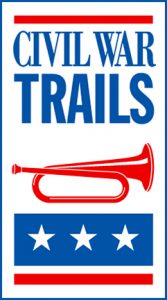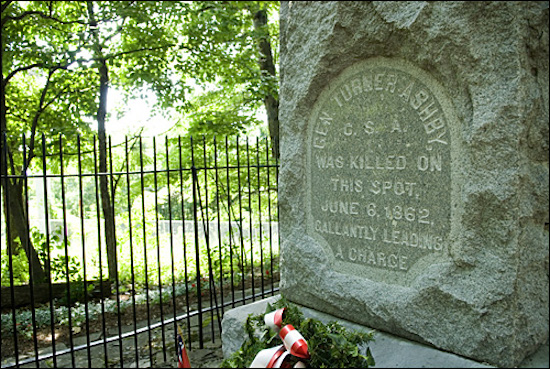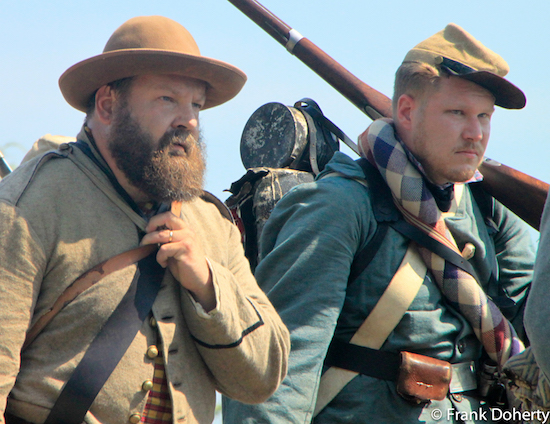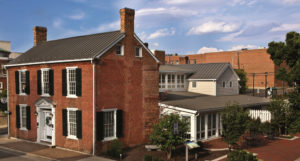Civil War Trails: Battles on the Home Front
 Civil War History in Harrisonburg
Civil War History in Harrisonburg
The Shenandoah Valley, Harrisonburg, and Rockingham County played significant roles during the Civil War. Harrisonburg and Rockingham County are home to 30 Civil War Sites, including six Civil War Trails markers and a Civil War Orientation Center in historic downtown Harrisonburg. Harrisonburg, at the crossroads of two major highways, the Valley Turnpike (modern-day Rt. 11) and the Rockingham Turnpike (modern-day Rt. 33), about 25 miles north of a huge Confederate rail and supply center in Staunton. At the time, Rockingham County was one of the most prosperous agricultural counties in the nation. The region, including Harrisonburg and Rockingham County, was known as “the bread-basket of the Confederacy,” making it a prime location for the struggle between Union and Confederate forces.
The Valley also set the stage for two important campaigns during the Civil War. Confederate General Thomas J.”Stonewall” Jackson’s famous 1862 Valley Campaign, which earned him a permanent place in military history. Also in 1864 when Union General Philip H. Sheridan ordered “The Burning” of the Valley.
Visit the Harrisonburg Rockingham Civil War Orientation Center, located in the Hardesty-Higgins House Visitor Center, for more information.
Civil War Sites
Gen. Nathaniel Banks Headquarters (Hardesty-Higgins House Visitor Center)
Harrisonburg Rockingham Civil War Orientation Center
The Valley Turnpike Museum
212 S. Main St. Harrisonburg, VA 22801
This Trails sign is located on North Main Street between Bruce and Franklin streets in Harrisonburg. Home to the town’s first mayor, Isaac Hardesty, this house was used briefly as headquarters for Union Gen. Nathaniel Banks as he tried to corner Stonewall Jackson in 1862. Located within the Hardesty-Higgins House Visitor Center, visitors will find The Valley Turnpike Museum and the Harrisonburg Rockingham Civil War Orientation Center. The Valley Turnpike Museum highlights the history of the Rt. 11 corridor as the avenue of invasion and the events surrounding it. The museum also has a scale model recreation of 1862 Harrisonburg and engine 199 on display. The Civil War Orientation Center offers visitors the stories of individuals, battles and campaigns through film and interpretation.
Harrisonburg’s Confederate General Hospital/Harrisonburg Female Academy (City of Harrisonburg Municipal Building)
345 S. Main St. Harrisonburg, VA 22801
Harrisonburg was Rockingham County’s seat of government and its largest town, an ideal site for a hospital. When the Civil War began in 1861, although the railroad had not yet extended to Harrisonburg, the town sat at the intersection of four turnpikes, including the Valley Turnpike, the main avenue for travel through Virginia’s Great Valley. Various buildings in Harrisonburg were used as temporary hospitals from the outset of the War; the most important of these was the Harrisonburg Female Academy on Main Street. It was converted to hospital use in 1861, and was known as the Harrisonburg Confederate General Hospital.
Warren-Sipe House
301 S. Main St. Harrisonburg, VA 22801
The Trails sign for this Civil War Site is located on North Main Street between Franklin Street and Ash Tree Lane in Harrisonburg, in front of the Warren-Sipe House. This was the home of Edward T.H. Warren, a Harrisonburg attorney and descendant of Thomas Harrison, the founder of Harrisonburg. Warren went to war early and fought in most of the famous battles in the East until he was killed at the Wilderness in 1864. The home’s structure was used as a hospital following the battle of Gettysburg in 1863 and it was here that Stonewall Jackson’s “Boy General,” Joseph Latimer died. Today, the historic home is open to the public as the Virginia Quilt Museum and interprets the history of the building. The museum also highlights the importance of quilting in society with contemporary and historic quilt exhibits throughout the year.
Court Square & Springhouse (Rockingham County Courthouse)
74 Court Square Harrisonburg, VA 22801
This Civil War Trails sign is located at Court Square in historic downtown Harrisonburg at the corner of North Main Street. The courthouse grounds were used as a prison pen following the first battle of Winchester in 1862. Soldiers and townsfolk quenched their thirst at the springhouse in the southwestern corner. Elder John Kline was a Dunker (Brethren) minister farmer of the Broadway, Virginia area who was imprisoned in the second floor jury room of the Rockingham County Courthouse starting on April 5, 1862. During Elder Kline’s 13 day stay in the courthouse, he wrote the refrain to what has been known as “The Prisoner’s Song.”
McNeill’s Rangers/Hill’s Hotel (Massanutten Regional Library)
174 S. Main St. Harrisonburg, VA 22801
Capt. John Hanson McNeill’s company of the 18th Virginia Cavalry became a Confederate partisan ranger unit on March 20, 1863. Nineteen days earlier, McNeill auctioned captured “horses and harness” at the courthouse in Harrisonburg for $36,000. On the morning of October 3, 1864, Capt. McNeill was mistakenly wounded by his own men while leading an attack on a Union camp in Shenandoah County. He died of his wounds on November 10 at Hill’s Hotel in Harrisonburg.
Lt. Jesse C. McNeill, the captain’s son, soon took over command of the company. A plan had been developed two years before; Captain Jesse McNeill had heard his father boast about a raid he was going to make into Cumberland, Maryland in order to capture two Federal generals. The prospective victims were generals Benjamin F. Kelley and George Crook.
Soldiers’ Cemetery at Woodbine – (Woodbine Cemetery)
212 Reservoir St. Harrisonburg, VA 22801
Woodbine Cemetery was chartered in March 1850. Later that same year a lot was purchased for burials when Harrisonburg’s first mayor, Isaac Hardesty, sold 2½ acres to the cemetery company. Woodbine was developed as the town’s main cemetery, and the need for gravesites for fallen Civil War soldiers became apparent early in the conflict. The nearby action where General Turner Ashby was killed and the battles at Port Republic and Cross Keys added additional burials, as did fatalities at Harrisonburg’s Confederate General Hospital. A one-acre lot was then donated by Harrisonburg merchant Samuel Shacklett for a “Soldiers’ Cemetery.” In June 1868 women from the town formed a Ladies Memorial Association, led by Mrs. Juliet Lyle Strayer. The Memorial Association provided care and maintenance for the graves of fallen Confederates buried there.
Brethren & Mennonite Heritage Center
1921 Heritage Center Way, Harrisonburg, VA 22801
The unique history of Harrisonburg and Rockingham County includes the settlement of a large group of Mennonite and Brethren, whose religious beliefs and role during the war are highlighted at Brethren & Mennonite Heritage Center. Primarily Union sympathizers, several events during the war, such as Sheridan’s Burning did not favor the southern Unionists. Valley Mennonite and Brethren lost their farms to fire as well.
Breneman-Turner Mill
5001 Turners Mill Ln, Harrisonburg, VA 22802
Built in 1800, the Breneman-Turner Mill is the only surviving gristmill in the county with its original equipment. The mill survived two unsuccessful attempts to burn it during General Sheridan’s 1864 campaign.
Turner Ashby Monument
1164 Turner Ashby Ln. Harrisonburg, VA 22801
Gen. Turner Ashby, in command of Jackson’s cavalry, was mortally wounded at this site, now marked with a monument and a small park. His death on June 6, 1862, immediately preceded the battles of Cross Keys and Port Republic. Walk to two Civil War interpretive signs about the engagement at “Chestnut Ridge” in 1862 where Turner Ashby. was killed, and another one depicting “The Battle of Harrisonburg in 1862” on the same day. The Turner Ashby Chapter of the United Daughters of the Confederacy No. 162 holds annual memorial observance of the death of Confederate Gen. Turner Ashby in June each year. Visitors and group tours are welcome.
Long’s Chapel at Zenda
1340 Fridleys Gap Rd, Harrisonburg, VA 22802
The story of African-American transition after the Civil War is featured at Long’s Chapel at Zenda in Harrisonburg. The chapel served as a spiritual and educational center of Zenda or “Little Africa,” a settlement formed after the Civil War by newly-freed slaves. Built between 1870 and 1871, the chapel was the first school for the community residents.
The Harriet Tubman Cultural Center
Visit by appointment only
2065 Reservoir St., Harrisonburg, VA | 540-578-6389
Located in a former one room school annex, visitors of the Harriet Tubman Cultural Center will experience a tribute to the legacy of Harriet Tubman and the Underground Railroad. Visitors can explore “Freedom Trail” markers on the property that include topics on the history of the Freedom Trail. Tours will inform visitors about Harriet Tubman’s life and legacy, a local safe house, plantation life, and more. (Harriet Tubman never visited the area but the Center housed in a building built in 1899 is a tribute to her legacy.) The Harriet Tubman Cultural Center began in 2010.
Admission is $10 for adults and free for students 12 and under. Visits are by appointment only. To make an appointment or for more information call (540) 578-6389.
Civil War Information
We invite you to pick up more information on the American Civil War and visit the Harrisonburg-Rockingham Civil War Orientation Center, located in the Hardesty-Higgins House Visitor Center.


